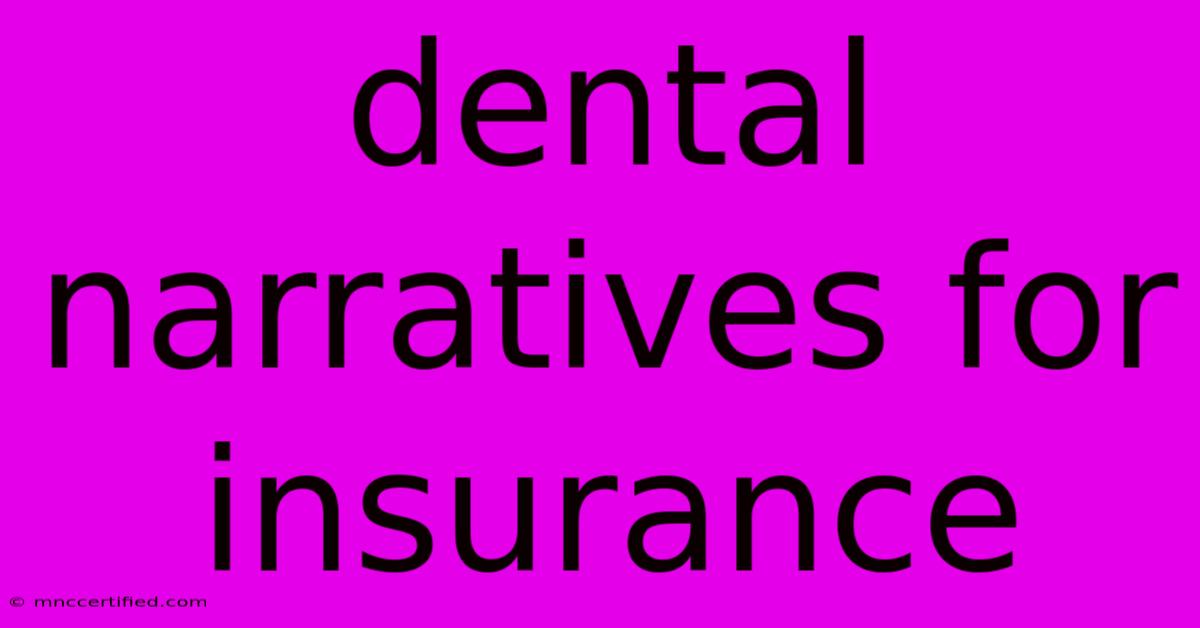Dental Narratives For Insurance

Table of Contents
Crafting Compelling Dental Narratives for Insurance Claims: A Comprehensive Guide
Submitting dental insurance claims can often feel like navigating a maze. While proper coding is crucial, a strong, clear narrative within your claim significantly improves the chances of successful reimbursement. This article will guide you through crafting compelling dental narratives that resonate with insurance providers and maximize your chances of approval.
Understanding the Importance of a Strong Dental Narrative
Insurance companies review thousands of claims daily. A well-written narrative differentiates your claim, providing context and justification for the procedures performed. It's not just about listing codes; it's about telling a story that supports the medical necessity of the treatment. A weak or unclear narrative can lead to delays, denials, or even partial payments.
Key Elements of a Winning Narrative:
-
Patient History: Begin by concisely summarizing the patient's relevant medical and dental history. Include any pre-existing conditions, past treatments, or relevant symptoms. For example: "Ms. Jones presented with a chief complaint of persistent pain in her lower left molar, exacerbated by chewing. She reported a history of periodontal disease and previous root canal treatment on the same tooth."
-
Clinical Findings: Detail your objective findings from the examination. Be precise and use professional terminology but avoid jargon. Include details like:
- Visual observations: "Examination revealed a deep carious lesion extending to the pulp."
- Diagnostic tests: "Radiographic imaging confirmed extensive periapical radiolucency consistent with a periapical abscess."
- Measurements: "Probing depths in the area ranged from 6-8mm, indicative of moderate periodontitis."
-
Diagnosis: Clearly state the diagnosis according to the accepted dental classification system (e.g., ICD-10 codes). Avoid ambiguity. For instance, instead of "toothache," specify "acute apical periodontitis."
-
Treatment Plan: Explain the rationale behind your treatment plan, emphasizing the medical necessity of each procedure. Connect the diagnosis to the treatment. For example: "Given the extensive periapical lesion and patient's reported pain, a root canal treatment was deemed necessary to preserve the tooth and alleviate the patient's discomfort. Post-treatment restoration was also indicated to protect the tooth structure."
-
Procedure Details: Clearly describe the procedures performed, including specific techniques used. This section should align perfectly with the codes submitted.
-
Prognosis: Briefly outline the expected outcome of the treatment and the potential for future complications if treatment wasn't undertaken. For example: "With successful root canal therapy and restoration, the prognosis for the tooth is good. Without treatment, extraction would have been likely."
Keywords to Enhance Your Narrative
Incorporate relevant keywords naturally throughout your narrative to improve search engine optimization (SEO) for your practice's online presence. Consider terms like: dental insurance claims, medical necessity, treatment justification, periodontal disease, root canal therapy, restorative dentistry, dental coding, ICD-10 codes, claim denials, insurance reimbursement.
Avoiding Common Mistakes
- Lack of Detail: Vague descriptions lead to claim denials. Be specific and comprehensive.
- Inconsistent Information: Ensure your narrative aligns perfectly with the treatment codes and supporting documentation.
- Jargon and Abbreviations: Use clear, concise language that is easily understood by insurance reviewers.
- Poor Grammar and Spelling: Professionalism is key. Proofread carefully before submission.
Optimizing Your Practice for Successful Claim Submissions
Beyond crafting strong narratives, consider these strategies for optimizing your practice's claim submission process:
- Invest in Dental Practice Management Software: Streamline the entire process from appointment scheduling to claim submission.
- Regularly Review Claim Denials: Analyze denied claims to identify patterns and improve future submissions.
- Maintain Accurate Patient Records: Detailed records serve as the foundation for a compelling narrative.
- Stay Updated on Insurance Regulations: Knowledge of current guidelines is essential for successful reimbursements.
By meticulously crafting compelling dental narratives and adopting efficient practice management strategies, you can significantly improve your chances of receiving timely and complete insurance reimbursements. Remember, a strong narrative isn't just about getting paid; it's about effectively communicating the value of your expertise and dedication to your patients.

Thank you for visiting our website wich cover about Dental Narratives For Insurance. We hope the information provided has been useful to you. Feel free to contact us if you have any questions or need further assistance. See you next time and dont miss to bookmark.
Featured Posts
-
Tractor Wave Floods Police Probe
Nov 26, 2024
-
Can I Cancel My Insurance Claim
Nov 26, 2024
-
Chief Investment Officer Summit
Nov 26, 2024
-
Worst Rated Insurance Companies
Nov 26, 2024
-
Predicted West Ham Lineup Vs Newcastle
Nov 26, 2024